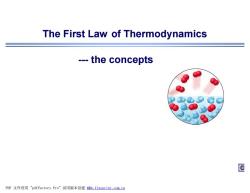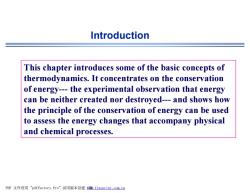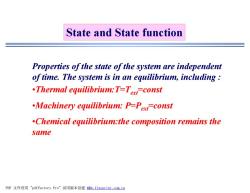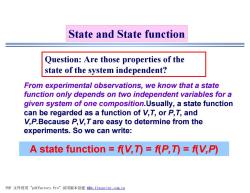北京化工大学:《物理化学》课程电子教案(理科双语)Chapter 2 First Law Of Thermodynamics

The First Law of Thermodynamics --the concepts @ PDF文件使用"pdfFactory Pro”试用版本创建m,fineprint..com,cn
The First Law of Thermodynamics --- the concepts PDF 文件使用 "pdfFactory Pro" 试用版本创建 f www.fineprint.com.cn ÿ

Contents .Introduction .The basic concepts .Work and heat State functions and exact differentials PDF文件使用"pdfFactory Pro”试用版本创建m,fineprint.com,cn
Contents •Introduction •The basic concepts •Work and heat •State functions and exact differentials PDF 文件使用 "pdfFactory Pro" 试用版本创建 ÿwww.fineprint.com.cn

Introduction This chapter introduces some of the basic concepts of thermodynamics.It concentrates on the conservation of energy---the experimental observation that energy can be neither created nor destroyed---and shows how the principle of the conservation of energy can be used to assess the energy changes that accompany physical and chemical processes. PDF文件使用"pdfFactory Pro”试用版本创建题,fineprint.com,c里
Introduction This chapter introduces some of the basic concepts of thermodynamics. It concentrates on the conservation of energy--- the experimental observation that energy can be neither created nor destroyed--- and shows how the principle of the conservation of energy can be used to assess the energy changes that accompany physical and chemical processes. PDF 文件使用 "pdfFactory Pro" 试用版本创建 fwww.fineprint.com.cn 瑡

Introduction .Thermodynamics is the science of heat and work and transformations of one to the other. 1st Law of Thermodynamics: Conservation of Energy Energy can neither be created nor destroyed. Begin with the concepts PDF文件使用"pdfFactory Pro”试用版本创建m,fineprint.com,cn
Introduction •Thermodynamics is the science of heat and work and transformations of one to the other. 1 st Law of Thermodynamics: Conservation of Energy Energy can neither be created nor destroyed. Begin with the concepts PDF 文件使用 "pdfFactory Pro" 试用版本创建 www.fineprint.com.cn

System and Surroundings System This is the part in which we haveaspecial interest. Surroundings 2 They are the rest of the universe,and where we make observations. The universe the system the surroundings PDF文件使用"pdfFactory Pro”试用版本创建mm,fineprint.com,cn
System and Surroundings System This is the part in which we have a special interest. Surroundings They are the rest of the universe, and where we make observations. The universe - the system + the surroundings PDF 文件使用 "pdfFactory Pro" 试用版本创建 3www.fineprint.com.cn

System and Surroundings .There are 3 kinds of systems: -Open system:matter and energy can be transferred between the system and its surroundings. -Closed system:only energy can be transferred between the system and its surroundings. -/solated system:neither matter nor energy contact with its surroundings PDF文件使用"pdfFactory Pro”试用版本创建m,fineprint.com,cn
•There are 3 kinds of systems: –Open system: matter and energy can be transferred between the system and its surroundings. –Closed system:only energy can be transferred between the system and its surroundings. –Isolated system:neither matter nor energy contact with its surroundings System and Surroundings PDF 文件使用 "pdfFactory Pro" 试用版本创建 f www.fineprint.com.cn ÿ

The Properties of System There are a series of properties to describe a given system,such as P,V,T,n,U,H...Some of them depend on the amount of substance present in the system,some are independent of the amount of material present .So we have two kinds of properties.They are: (1)Extensive properties---increase in proportion to the amount of the system,i.e.,V,n,U,H (2)Intensive properties---are not related to the amount of the system,i.e.,P,T,Vm PDF文件使用"pdfFactory Pro”试用版本创建fmm,fineprint.com,c里
The Properties of System There are a series of properties to describe a given system,such as P,V,T,n,U,H… Some of them depend on the amount of substance present in the system,some are independent of the amount of material present .So we have two kinds of properties. They are: (1)Extensive properties---increase in proportion to the amount of the system, i.e., V,n,U,H (2) Intensive properties---are not related to the amount of the system, i.e., P,T,Vm PDF 文件使用 "pdfFactory Pro" 试用版本创建 fwww.fineprint.com.cn

State and State function Properties State Properties depend on the state of the system.A system in a particular state possesses a particular amount of each property.Properties of the state of the system,are called state functions. The most important point is that a state function,being a property of the present state of the system,is independent of the way the state was prepared. PDF文件使用"pdfFactory Pro”试用版本创建m,fineprint.com,cn
State and State function Properties State Properties depend on the state of the system. A system in a particular state possesses a particular amount of each property. Properties of the state of the system, are called state functions. The most important point is that a state function, being a property of the present state of the system, is independent of the way the state was prepared. PDF 文件使用 "pdfFactory Pro" 试用版本创建 ÿwww.fineprint.com.cn

State and State function Properties of the state of the system are independent of time.The system is in an equilibrium,including Thermal equilibrium:T=Tex=const Machinery equilibrium:P=Pex=const Chemical equilibrium:the composition remains the same PDF文件使用"pdfFactory Pro”试用版本创建m,fineprint.com,cn
Properties of the state of the system are independent of time. The system is in an equilibrium, including : •Thermal equilibrium:T=Text =const •Machinery equilibrium: P=Pext =const •Chemical equilibrium:the composition remains the same State and State function PDF 文件使用 "pdfFactory Pro" 试用版本创建 f www.fineprint.com.cn ÿ

State and State function Question:Are those properties of the state of the system independent? From experimental observations,we know that a state function only depends on two independent variables for a given system of one composition.Usually,a state function can be regarded as a function of V,T,or P,T,and V,P.Because P,V,T are easy to determine from the experiments.So we can write: A state function =f(V,)=f(P,T)=f(V,P) PDF文件使用"pdfFactory Pro”试用版本创建m,fineprint.com,cn
From experimental observations, we know that a state function only depends on two independent variables for a given system of one composition.Usually, a state function can be regarded as a function of V,T, or P,T, and V,P.Because P,V,T are easy to determine from the experiments. So we can write: State and State function A state function = f(V,T) = f(P,T) = f(V,P) Question: Are those properties of the state of the system independent? PDF 文件使用 "pdfFactory Pro" 试用版本创建 f www.fineprint.com.cn ÿ
按次数下载不扣除下载券;
注册用户24小时内重复下载只扣除一次;
顺序:VIP每日次数-->可用次数-->下载券;
- 北京化工大学:《物理化学》课程电子教案(理科双语)Chapter 1 The properties of gases.pdf
- 北京化工大学:《物理化学》课程电子教案(理科双语)Chapter 0 PYHSICAL CHEMISTRY(Introduction).pdf
- 北京化工大学:《物理化学》课程教学资源(作业习题)计算题化学动力学(含参考答案).pdf
- 北京化工大学:《物理化学》课程教学资源(作业习题)计算题表面胶体化学(含参考答案).pdf
- 北京化工大学:《物理化学》课程教学资源(作业习题)计算题统计热力学(含参考答案).pdf
- 北京化工大学:《物理化学》课程教学资源(作业习题)计算题相平衡(含参考答案).pdf
- 北京化工大学:《物理化学》课程教学资源(作业习题)计算题电化学(含参考答案).pdf
- 北京化工大学:《物理化学》课程教学资源(作业习题)计算题多组分热力学(含参考答案).pdf
- 北京化工大学:《物理化学》课程教学资源(作业习题)计算题热力学第二定律(含参考答案).pdf
- 北京化工大学:《物理化学》课程教学资源(作业习题)计算题热力学第一定律(含参考答案).pdf
- 北京化工大学:《物理化学》课程教学资源(作业习题)计算题气体pVT关系(含参考答案).pdf
- 北京化工大学:《物理化学》课程教学资源(作业习题)物理化学(下册)提高题及参考答案(第7-11章).pdf
- 北京化工大学:《物理化学》课程教学资源(作业习题)物理化学(上册)提高题及参考答案(第1-6章).pdf
- 北京化工大学:《物理化学》课程教学资源(作业习题)2010-2011年第一学期物理化学(上册)期末试题.doc
- 北京化工大学:《物理化学》课程教学资源(作业习题)2009-2010年第一学期物理化学(上册)期末试题.doc
- 北京化工大学:《物理化学》课程教学资源(实验指导)治理工业含苯废气Cu-Mn-O复合氧化物催化剂的活性评价.pdf
- 北京化工大学:《物理化学》课程教学资源(实验指导)用差热分析方法测定催化剂的还原度及还原活化能.pdf
- 北京化工大学:《物理化学》课程教学资源(实验指导)镁铝水滑石清洁合成组成分析及其晶体结构表征.pdf
- 北京化工大学:《物理化学》课程教学资源(实验指导)脉冲色谱法研究分子筛催化剂催化异丙苯裂解反应动力学.pdf
- 北京化工大学:《物理化学》课程教学资源(实验指导)固体吸附剂比表面的测定.pdf
- 北京化工大学:《物理化学》课程电子教案(理科双语)Chapter 3 The Second Law of Thermodynamics.pdf
- 北京化工大学:《物理化学》课程电子教案(理科双语)Chapter 4 The thermodynamics of mixtures.pdf
- 北京化工大学:《物理化学》课程电子教案(理科双语)Chapter 5 Chemical Equilibrium.pdf
- 北京化工大学:《物理化学》课程电子教案(理科双语)Chapter 6 Phase Equilibrium.pdf
- 北京化工大学:《物理化学》课程电子教案(理科双语)Chapter 7 Electrochemistry.pdf
- 北京化工大学:《物理化学》课程电子教案(理科双语)Chapter 8 Elementary Statistical Thermodynamics.pdf
- 北京化工大学:《物理化学》课程电子教案(理科双语)Chapter 9 Surfaces(Interfacial Chemistry).pdf
- 北京化工大学:《物理化学》课程电子教案(理科双语)Chapter 10 Chemical Reaction Kinetics.pdf
- 北京化工大学:《物理化学》课程电子教案(理科双语)Chapter 11 Colloid Chemistry.pdf
- 北京化工大学:《物理化学》课程电子教案(PPT教学课件,工科化工专业)第一章 绪论与气体pVT关系(性质)Physical Chemistry.pps
- 北京化工大学:《物理化学》课程电子教案(PPT教学课件,工科化工专业)第三章 热力学第二定律 The second law of thermodynamics.pps
- 北京化工大学:《物理化学》课程电子教案(PPT教学课件,工科化工专业)第二章 热力学第一定律 The first law of thermodynamics.pps
- 北京化工大学:《物理化学》课程电子教案(PPT教学课件,工科化工专业)第四章 多组分系统热力学 Thermodynamics for open systems.pps
- 北京化工大学:《物理化学》课程电子教案(PPT教学课件,工科化工专业)第九章 电化学 Electrochemistry.pps
- 北京化工大学:《物理化学》课程电子教案(PPT教学课件,工科化工专业)第十章 界面化学 Surface Chemistry.pps
- 北京化工大学:《物理化学》课程电子教案(PPT教学课件,工科化工专业)第五章 化学平衡 Chemical equilibrium.pps
- 北京化工大学:《物理化学》课程电子教案(PPT教学课件,工科化工专业)第七章 统计热力学初步 Statistical Thermodynamics.pps
- 北京化工大学:《物理化学》课程电子教案(PPT教学课件,工科化工专业)第六章 相平衡 Phase equilibrium.pps
- 北京化工大学:《物理化学》课程电子教案(PPT教学课件,工科化工专业)第十一章 胶体化学 Colloid Chemistry.pps
- 北京化工大学:《物理化学》课程电子教案(PPT教学课件,工科化工专业)第八章 化学反应动力学 Chemical reaction dynamics.pps
